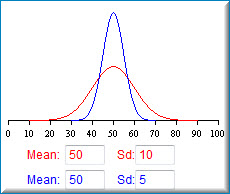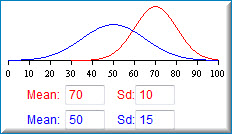7.4: Varieties Demonstration
- Page ID
- 2120
Learning Objectives
- Be able to describe differences in distributions based on their shape and statistics
Instructions
This demonstration allows you to change the mean and standard deviation of two normal distributions and observe the effects on the shapes of the distributions.When the demonstration begins, the red distribution has a mean of \(50\) and a standard deviaton of \(10\). The blue distribution has a mean of \(50\) and a standard deviation of \(5\). Notice how much more spread out the red distribution is than the blue distribution.
Choose different values for the two distributions and investigate their effects.
Illustrated Instructions
The demonstration starts by displaying two curves both with a mean of \(50\) and with standard deviations of \(10\) and \(5\) respectively. You can change the values for the mean and standard deviation for both curves.

The screenshot below shows the distributions with different means and standard deviations. Note that the curves are on an axis that ranges from \(0 - 100\), keep this in mind when changing the values of the mean and standard deviations as some values will not be displayed correctly.



